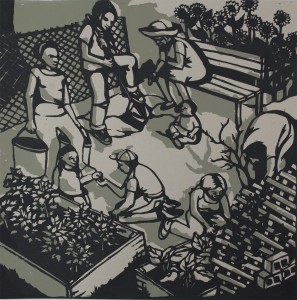Poem: The New Warden by Jimmy Santiago Baca
Born in 1952 in Santa Fe of Chicano and Apache descent, Jimmy Santiago Baca was abandoned by his parents and at 13 ran away from the orphanage where his grandmother had placed him. He was convicted on drug charges in 1973 and spent five years in prison. There he learned to read and began writing poetry. His semiautobiographical novel in verse, Martin and Meditations on the South Valley (1987), received the 1988 Before Columbus Foundation’s American Book Award in 1989. In addition to over a dozen books of poetry, he has published memoirs, essays, stories, and a screenplay, Bound by Honor (1993), which was made into a feature-length film directed by Taylor Hackford.
The New Warden
by Jimmy Santiago Baca (1979)He sat in the cool morning.
He had a handful of apple seeds in his palm.
He sat there contemplating
Where he would plant them.
A month later he tore the kitchen down
and planted apple seeds there.
Some of the convicts asked him why.
“Apples, “ he said, “is one of America’s
great traditional prides. Remember
the famous ballad Johnny Apple Seed?”
No one had heard of it, so he set up
A poetry workshop where the death house had been.
The chair was burned in a great ceremony
Some of the Indian convicts performed
Ancient rituals for the souls of those executed in the past.
He sold most of the bricks and built
Little ovens in the earth with the rest.
The hospital was destroyed except for one new wing
To keep the especially aged infirm ones.
And funny thing, no one was ever sick.
The warden said something about freedom being the greatest cure
For any and all ailments. He was right.
The cellblocks were razed to the ground,
Some of the steel was kept and a blacksmith shop went up.
With the extra bricks the warden purchased
Tents, farming implements and bought a big yellow bus.
The adjoining fields flowed rich with tomatoes, pumpkins,
Potatoes, corn, chili, alfalfa, cucumbers.
From the nearby town of Florence, and as far away as Las
Cruces,
People came to buy up loads and loads of vegetables.
In one section of the compound the artists painted
Easter and Christmas and other holiday cards on paper
previously used for disciplinary reports,
The government even commissioned some of the convicts
To design patriotic emblems.
A little group of engineers, plumbers, electricians
Began building solar heating systems and sold them
To elementary schools under cost. Then,
Some citizens groups grew interested. Some high school kids
Were invited to learn about it, and soon,
Solar systems were being installed in the community.
An agricultural program opened up.
Unruly convicts were shipped out to another prison.
After the first year, the new warden installed ballot boxes.
A radio and TV shop opened. Some of the convict’s sons
And daughters came into prison to learn from their fathers’
trades and talking with them about life.
This lead to several groups opening up sessions dealing with
Language, logic, and delving into past myths and customs.
Blacks, Mejicanos, Whites, all had so much to offer
Discussing what they found to be untouched by past historians.
Each day six groups of convicts went into the community,
Working for the aged and infirmed.
One old convict ended up marrying the governor’s mother.

